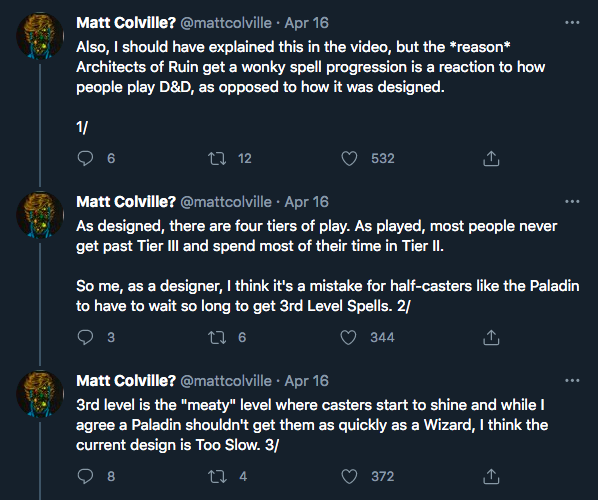This week, Matt Colville’s MCDM Productions released the official publication of the Illrigger, a custom class originally designed by Colville and inspired by MCDM Producer Anna Coulter’s request for a Hell Knight of Asmodeus for their actual play campaign, The Chain of Acheron.
It’s very good. The style is crisp, the art is beautiful, the narrative is robust and evocative, the design is interesting and interlocking. Each of the subclasses has a strong identity: the Painkiller is the tank, the Shadowmaster is the skirmisher, and the Architect of Ruin is arcane. Beyond multiple subclasses, there’s Colville’s signature story introduction, a stat block for a named NPC from Colville’s world, retainers for each subclass and new spells. All 120 stars.
Let’s focus on two facets of the design:
- one that legitimizes classic 5e design principle that’s being abandoned
- one that explores new ground for mixed martial spellcasters
Modifier-Based Features
The signature ability of the Illrigger is Baleful Interdict. At 3rd level, it gives the Illrigger a number of “seals” equal to your Charisma modifier. The base use is that they can be consumed to deal “smite” damage (and siphon back a little health, a recurring theme).
The seals also serve as a central cog that can interact with other features. Each of the Illrigger subclasses gets Interdict Improvements at levels 6/10/18. These improvements provide different uses or benefits that thematically align with the subclasses. But, they’re also supported by other features.
Since this is such a critical feature for the Illrigger, it’s essential that they get a fair number of uses (even with a short rest reset). So, the number of uses scales based off your Charisma modifier.
This is an interesting design decision, but only because of recent trends from Wizards of the Coast. Feature design in 5e has trended away from scaling feature uses based on ability score modifiers, opting instead for scaling based on proficiency bonus. But, design isn’t always the best fit just because it’s new.
The Illrigger shows that there is still design space for feature scaling based off of ability score modifiers. Especially where an early-level feature serves as a design nexus. The Illrigger rounds this out by supplementing the design with an emphasis on features that support the related ability score (e.g. Forked Tongue setting a floor on social skill rolls).
While proficiency scaling can cap out with more uses in Tier 4, scaling based off ability modifiers favors the more frequented lower tiers of play, as Colville discusses was intended in the context of the next topic.
2/3 Spellcasting
Core 5th Edition has:
- full casters (Bard, Cleric, Druid, Sorcerer, Wizard)
- half-casters (Paladin, Ranger)
- 1/3-casters (Arcane Trickster, Eldritch Knight)
- pact magic (Warlock)
When Artificer was added (originally in Wayfinder’s Guide to Eberron, officially in Eberron: Rising from the Last War), it was sometimes referred to as a 2/3-caster because it’s a half-caster with cantrips. But, there was also a group of folks who thought it should be designed with more of a 2/3-caster spell progression to give it access to cooler spells sooner.
The Architect of Ruin subclass has done just that. And, Colville took to Twitter to disclose the motivation was to cater to how players actually enjoy the game:
The Illrigger has a smooth 2/3-caster progression filled out by a sensible spell list. It would make a good template for anyone looking to design a 2/3-caster.
Suitable design can be found in the classics or by pushing the envelope. You can pick up a copy of The Illrigger for $6.66 on the MCDM Store. You can find more design lessons and support the blog on the ThinkDM Patreon.

Reblogged this on DDOCentral.
LikeLike
It feels extremely weird to design a feature around “how people actually play” versus how the game was designed in regards to class design. This kind of thinking is what exacerbates the problem of folks not playing higher tier games, as having more exciting options occur at higher levels encourages folks to explore these areas of play.
In the paladin example, that class has TONS of powerful and exciting features pre Tier 3 (there is a reason its the most powerful class in the game, and its not because of their spellcasting!), so them having to wait to get some of their favorite goodies is a very acceptable carrot that encourages Players to climb higher. While the Illrigger may not have these issues (I haven’t given it a close enough look to make a determination in that regard), having to wait to get some of your best goodies is not a bad thing. Front loading classes with all their most exciting features and leaving the less interesting options for later makes D&D less diverse and interesting, not more.
LikeLiked by 1 person
Do you feel it was a necessary class for general play, or are the evil Paladins and various Warlocks already covering the territory?
LikeLike
There’s more than one way to skin a cat.
LikeLike
For sure, but does it fill enough new story-space?
LikeLike
I guess it depends on what you mean by “general play”. You can reflavor almost anything to have it look and feel like you want it, so in some degrees the Oathbreaker or some of the Warlock subclasses can fulfill the “Knight of Hell” vision… but Illrigger delivers on what it promises – a martial class that draws its inspiration directly from Hell, which is something that isn’t available in the official 5e materials. The class’ features and mechanics are definitely unique enough that there’s no real overlap between Illrigger and the other class archetypes, so I don’t personally feel like it is invading already-taken territory.
LikeLiked by 1 person